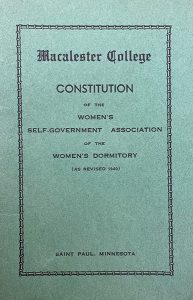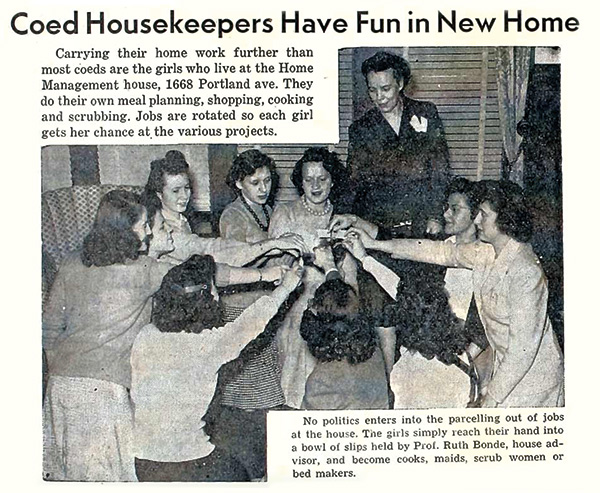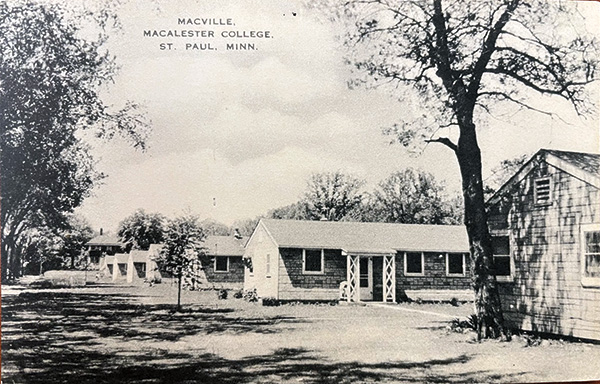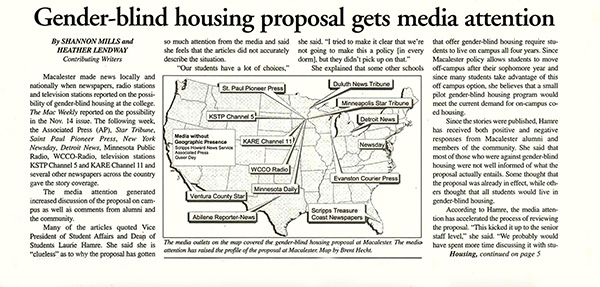
By Talia Bank ’23
Most weeknights last fall, you could find Andie Walker ’23 and her friends bonding over cooking and sharing vegetarian meals together in an on-campus residence hall. They chopped, grated, and sautéed in a bustling kitchen and enjoyed common spaces with high ceilings and tall windows, a function of its location directly underneath the Macalester Stadium’s seating sections. It’s a unique housing option, by design: each year, up to twenty students live in the Veggie Co-Op, which has served as an intentional meat-free living community since 1992.
As Walker settled into her temporary home, she started to wonder about the history of the Veggie Co-Op, as well as the nearly two dozen other student housing options on campus that range from traditional residence halls to language and special-interest housing. She turned her questions into an independent study for her digital history communications major, delving into Macalester’s archives and creating a digital timeline to visualize the history of student housing. We asked her about the process—and what she learned.
Q: How does your timeline project align with your academic interests and major?
A: In my sophomore year, I decided to design my own digital history communications major.
I really enjoyed my history classes and my computer science classes, but I didn’t see a lot of opportunities to combine them. I took a very interdisciplinary class called “Intro to Data Storytelling” and it got me thinking about designing a major that had to do with using software to do research, but also communicate history in a way that’s more accessible to the public.
Q: Why did you choose a digital format for the project?
A: The internet has often been used just for converting analog versions of media like books into web pages: a huge block of text that you just scroll through. But there are other options for communicating that are more suited to being online, or actually designed to live on the internet: for example, clicking through an interactive map or exhibit. I thought that would be a really interesting avenue to go down for history.
Q: What materials did you use to compile the timeline?
A: I started by looking at the college catalogs, which was a tedious process, but each catalog’s PDF is searchable. Any time housing information changed, I would make a note of what was added or what happened. That took a long time, but then I had a good understanding of what halls even existed—a lot of buildings don’t exist anymore, so we never talk about them and wouldn’t even
know to look them up. After that, I visited the archives and looked at old photographs and newspaper clippings. I also looked at The Mac Weekly database. There would be tons of letters to the editor in every edition. It seems like it was more how the college communicated; whereas now that happens mostly on the internet, and I thought that was really cool.
Q: What stood out to you?
A: I read anecdotes from people who had lived in Wallace, which used to be a women’s hall, and almost all of the stories were about residents running to get back in time, or sneaking through windows to avoid getting in trouble for not making curfew. I was really shocked because I thought it made sense for that kind of curfew to exist in the ’30s and ’40s, but I was really surprised that it continued to exist until the late ’60s. And during that time, men were only allowed in certain parts of Wallace Hall—one student remembered the men from Kirk Hall singing up to the windows. That was really a shock to see that kind of restriction had existed gender-wise so late into our history; there was a lot of separation.
I also noticed that in historical Mac Weekly issues, people would write in their own voice instead of taking a more journalistic tone, which seems to happen more today. People would be like, “The college is thinking about building a dorm in the stadium. That is such a bad idea. Why would you ever do that?” I thought that was funny. I lived there, and it’s great—it’s one of the nicest places I’ve lived on campus.
We asked Andie to share five chapters of student housing in Mac’s history that stood out to her.
1940: Life at Wallace Hall

“Many halls in Macalester’s history practiced self-government. Students often elected their leadership: A 1940 Wallace Hall constitution explains that a president, vice-president, secretary, and treasurer will govern the hall, in coordination with faculty and staff. The constitution also features bylaws for living in Wallace, including quiet hours after 10:15 p.m. every night, during which residents should wear ‘bedroom slippers with soft heels’ and avoid practicing musical instruments.”
1943: The Home Management House

“The Home Management House was established as a new option for female students who, according to The Mac Weekly, helped to cook, clean, and manage the house. At the time, Macalester offered a major and minor in home economics, and a home management class in the department served as a prerequisite for living in the house. The house continued to be an option for students through 1950.”
1946: Macville

“After the end of World War II, Macalester saw an influx of veteran students. In 1946, the Federal Public Housing Administration constructed several temporary homes, meant to house thirty-two married and thirty-two single veterans attending Macalester as part of an effort to accommodate the growing student body.”
1966: Students Fed Up with Dorm Rules for Women

“Since Wallace Hall’s opening, women living in campus housing were required to return to their dorms by specific times at night. By the 1960s, many students were fed up with the policy. In 1966, The Mac Weekly conducted a survey of seventy female students, 90 percent of whom said they were in favor of changing the restrictions. ‘Any woman twenty-one or twenty-two years old certainly can’t be emancipated’ when she has to be in at 12 on weeknights, argued one respondent.”
2003: Gender-Blind Housing Proposed

“In fall 2003, the college proposed a pilot program that would test out gender-blind housing in order to provide increased support for LGBTQ students. News of the proposal caught the attention of alumni and reporters across Minnesota and nationally, with some in favor and others against.”
April 21 2022
Back to top





